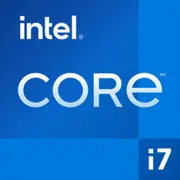Intel Core i7-7500U

Intel Core i7-7500U in 2025: Is it Worth Considering an Outdated Processor?
A Structured Analysis for Practical Choices
Architecture and Process Technology: Why Kaby Lake is Still Relevant
The Intel Core i7-7500U processor, released in 2016, belongs to the Kaby Lake generation. Despite its age, it continues to be found in budget laptops and discounted devices. Its key specifications include:
- 14nm process technology — an outdated technology by 2025 standards, where 5-7nm chips dominate.
- 2 cores, 4 threads (Hyper-Threading) — the minimal configuration for basic multitasking.
- Clock speeds: base frequency — 2.7 GHz, turbo mode — up to 3.5 GHz.
- Integrated graphics: Intel HD Graphics 620 with a clock speed of 1050 MHz. It supports 4K video but is not designed for gaming.
Architectural Features:
Kaby Lake is an optimization of the previous Skylake generation. Key improvements include support for HDMI 2.0, HEVC encoding, and enhanced energy efficiency. However, the lack of AVX-512 support and a limited cache (4 MB) make it a weak point for modern AI or 3D rendering tasks.
Power Consumption and TDP: Balancing Power and Longevity
A TDP of 15W allows the processor to be used in ultrabooks and thin laptops. However, by 2025, this is no longer a benchmark: competitors like the Apple M1 (10W) or AMD Ryzen 5 5500U (15W) offer more cores and higher performance within the same thermal envelope.
Why is TDP Important?
- Laptops with the i7-7500U typically come equipped with passive or compact cooling systems.
- Low heat output allows devices to be less than 15 mm thick but limits performance under load.
Performance: What Can a 2016 Processor Do in 2025?
Office Work:
- Easily handles web browsing (10-15 tabs), Word, and Excel.
- Slowdowns may occur when simultaneously working with Zoom and heavy PDF files.
Multimedia:
- Streaming 4K video (Netflix, YouTube) — no issues thanks to HEVC decoding.
- Photo editing in Lightroom: acceptable for basic retouching, but exporting 100+ photos takes 15-20 minutes.
Gaming:
- CS:GO — 30-40 FPS on low settings (720p).
- Fortnite — 20-25 FPS (720p, minimum graphics).
- Modern AAA titles (2024-2025) — not recommended.
Turbo Boost Mode:
The processor briefly boosts to 3.5 GHz, but under sustained load (for example, video rendering), the frequency drops to 2.8-3.0 GHz due to overheating.
Usage Scenarios: Who Would Benefit from the i7-7500U in 2025?
1. Students: For study (documents, presentations, online courses).
2. Office Workers: Handling emails, cloud services, light CRM systems.
3. Budget-Conscious Users: Laptops with this CPU can be found for $400-$600.
Who Should Avoid It:
- Gamers, video editors, programmers working with Docker or virtualization.
Battery Life: How Long Will the Laptop Last Without a Power Outlet?
With a battery capacity of 50 Wh (typical for ultrabooks from 2017-2020), the runtime will be:
- 6-8 hours — web surfing, office tasks.
- 3-4 hours — 4K video watching.
Power-Saving Technologies:
- Speed Shift: Dynamic frequency management to reduce latency.
- C-States: Turning off unused cores during idle time.
- Display Power Saving: Automatically reduces screen brightness.
Tip: By 2025, even budget laptops with Intel’s 12th generation processors or AMD Ryzen 5000 series offer 30-50% better battery life.
Comparison with Competitors: What to Choose Instead of i7-7500U?
1. AMD Ryzen 3 5300U (4 cores/8 threads, 15W, Geekbench 6 Multi-Core: ~4500): twice as powerful in multi-threaded tasks. Laptops starting from $550.
2. Apple M1 (8 cores, 10W, Geekbench 6 Multi-Core: ~7500): an absolute leader in battery life and performance. Devices starting from $800 (new).
3. Intel Core i3-1215U (6 cores/8 threads, 15W, Geekbench 6 Multi-Core: ~5200): supports DDR5 and PCIe 4.0. Laptops starting from $600.
Conclusion: The i7-7500U falls short against even budget modern CPUs, but may be justifiable only for those on a strict budget.
Pros and Cons: Is It Worth Buying?
Pros:
- Low device prices ($400-$600).
- Sufficient performance for basic tasks.
- Compact and lightweight designs (1.2-1.5 kg).
Cons:
- Only 2 cores — limited multitasking capabilities.
- No support for Wi-Fi 6, Thunderbolt 4.
- Weak upgrade potential: RAM is often soldered, SSD slots are usually limited to SATA.
Recommendations for Choosing a Laptop
If you still decide to purchase a device with the i7-7500U in 2025:
1. Type of Device: Ultrabook (e.g., used Dell XPS 13 9360) or budget laptop (HP Pavilion 15).
2. RAM Size: At least 8 GB, preferably 16 GB for Windows 11.
3. Storage: SSD is a must (NVMe preferred over SATA).
4. Screen: Full HD (1920×1080) — less strain on GPU.
5. Cooling: Check reviews for overheating issues.
Examples of New 2025 Low-End Laptops:
- Lenovo IdeaPad 3 with AMD Ryzen 5 5500U ($550).
- Acer Aspire 5 with Intel Core i3-1215U ($600).
Final Conclusion: Who would Benefit from the Core i7-7500U in 2025?
This processor is suitable for:
- Users needing a cheap laptop strictly up to $500.
- Scenarios without demanding multitasking (e.g., working in Google Docs + Zoom).
- The secondary market: refurbished devices with a warranty.
Key Benefits:
- Low cost.
- Proven reliability (architecture without critical bugs).
- Compact form factor.
Risks:
- Rapid obsolescence: support for Windows 12 (if released) is questionable.
- Limited upgrade potential.
Alternative: If the budget allows for an additional $100-$200, it’s better to choose a laptop with a processor from 2023-2024 — this will extend its relevance by 3-4 years.
In 2025, the Intel Core i7-7500U is a niche solution. It is suitable only for those willing to sacrifice performance for a minimal budget. In all other cases, it is advisable to look at modern alternatives.
Basic
CPU Specifications
Memory Specifications
GPU Specifications
Miscellaneous
Benchmarks
Compared to Other CPU
Share in social media
Or Link To Us
<a href="https://cputronic.com/index.php/cpu/intel-core-i7-7500u" target="_blank">Intel Core i7-7500U</a>